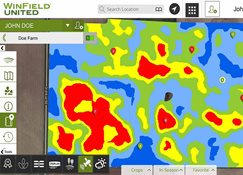Zone Soil Sampling Provides Another Layer of Data
May 16, 2019

A great complement to variable-rate application is zone-based soil sampling, which can help you achieve higher yield potential and improve ROI potential.
Evolution of soil sampling
Soil sampling has been a common practice for a number of years. Historically, a composite field- average sample was taken, then the results indicated the available nutrients in the soil and what nutrients at what rate should be added to achieve a desired yield goal.
With today’s technology advancements and continued grower adoption of variable-rate application strategies, the more sophisticated techniques of zone- or grid-based soil sampling have become common. These practices help ensure there are no missed opportunities to capture more yield or to save on inputs within the management zones of a field.
When inputs are under-applied, yield can be limited, even in the most productive areas. On the other hand, using too many inputs in low-producing areas gives the crop more nutrients than it actually needs, which is an inefficient use of input dollars. Both of these situations can result in reduced yield potential and lower profit potential. That’s why it is essential to differentiate between the higher- and lower-producing areas within your fields. I recommend using zone-based soil sampling to identify exactly what nutrients your crop needs.
Get in the “zone”
Depending on your geography, zone soil sampling can be more cost-effective than grid sampling. While both options are effective, grid sampling may require many more samples and much more time, resulting in a higher cost. Zone soil sampling will cost less, but it will still give you valuable information about nutrient variability in the field.
The R7® Tool by WinField United can be used to identify your field management zones for zone soil sampling. Work with your agronomist to decide the optimal soil sampling method and number of zones to test for your operation. When soil testing is complete, you can then use the additional layer of information gained from the zones samples to help make your variable-rate prescription plans and input decisions much more effective.
Evolution of soil sampling
Soil sampling has been a common practice for a number of years. Historically, a composite field- average sample was taken, then the results indicated the available nutrients in the soil and what nutrients at what rate should be added to achieve a desired yield goal.
With today’s technology advancements and continued grower adoption of variable-rate application strategies, the more sophisticated techniques of zone- or grid-based soil sampling have become common. These practices help ensure there are no missed opportunities to capture more yield or to save on inputs within the management zones of a field.
When inputs are under-applied, yield can be limited, even in the most productive areas. On the other hand, using too many inputs in low-producing areas gives the crop more nutrients than it actually needs, which is an inefficient use of input dollars. Both of these situations can result in reduced yield potential and lower profit potential. That’s why it is essential to differentiate between the higher- and lower-producing areas within your fields. I recommend using zone-based soil sampling to identify exactly what nutrients your crop needs.
Get in the “zone”
Depending on your geography, zone soil sampling can be more cost-effective than grid sampling. While both options are effective, grid sampling may require many more samples and much more time, resulting in a higher cost. Zone soil sampling will cost less, but it will still give you valuable information about nutrient variability in the field.
The R7® Tool by WinField United can be used to identify your field management zones for zone soil sampling. Work with your agronomist to decide the optimal soil sampling method and number of zones to test for your operation. When soil testing is complete, you can then use the additional layer of information gained from the zones samples to help make your variable-rate prescription plans and input decisions much more effective.